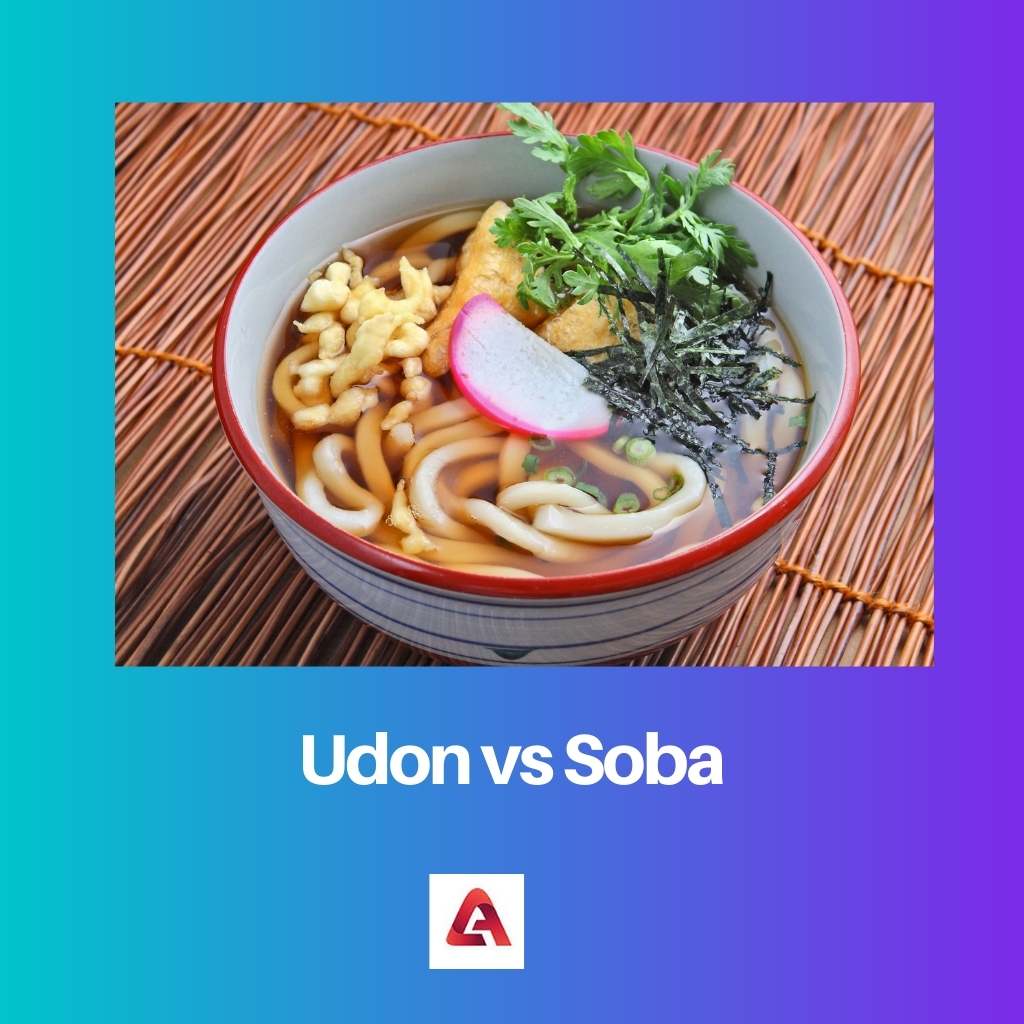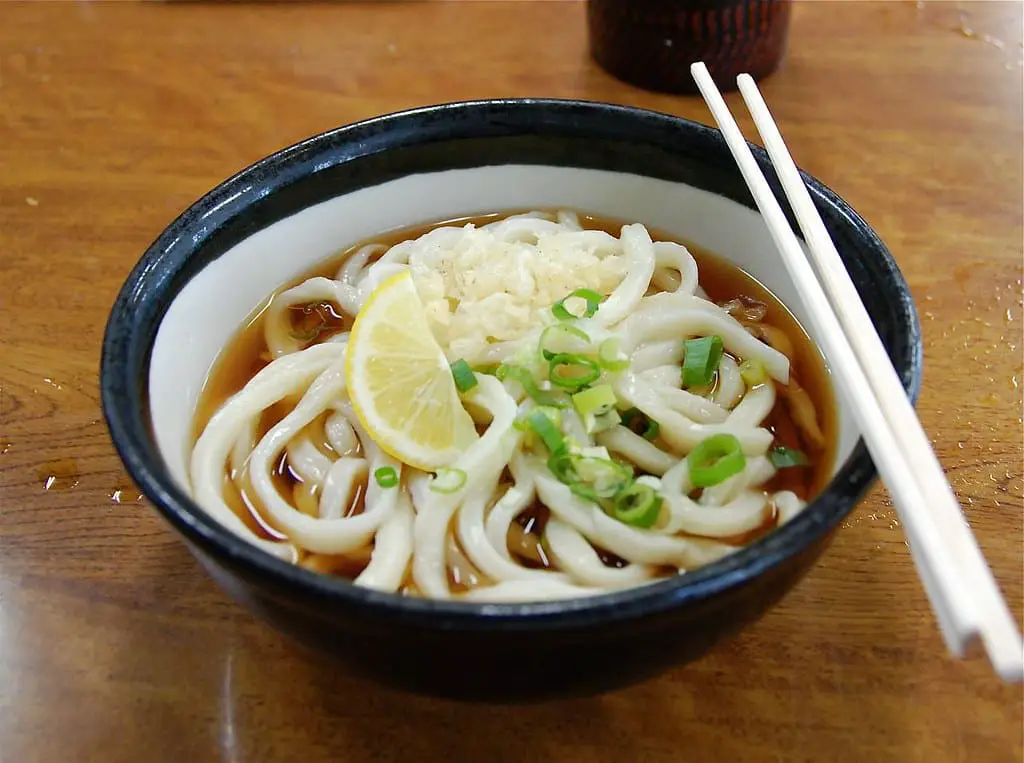Noodles have always been one of the most loved delicacies. Though they have originated in China they are loved and cooked in every country in the world.
Evidence shows that noodles were found in China 4000 years ago. Now, noodles come in different flavours and types. Chefs started making noodles with a traditional touch of their cuisine.
Key Takeaways
- Udon noodles are thick, chewy wheat noodles, while soba noodles are thinner and made from a blend of wheat and buckwheat flour.
- Soba noodles have a nutty flavor and firmer texture compared to udon noodles’ softer, milder taste.
- Udon is served in hot soups or stir-fries, while soba can be served cold with dipping sauce or in hot broth.
Udon vs Soba
Udon noodles are thick, chewy, and made from wheat flour. They have a neutral taste and are used in soups or stews. Soba noodles are thinner and made from buckwheat flour or a mixture of buckwheat and wheat flour. Soba noodles have a nutty flavour and a firmer texture than udon noodles.

Udon is light-colored and made from wheat flour. It is chewy and thick.
It is eaten either cold or hot. It can be cooked either in fresh form or in dried form.
Udon is cooked in different ways. Kake udon, Yaki udon, Kitsune udon, and Tanuki udon are some of the udon dishes made in Japan.
Soba is darker colored noodles. It is thin and has a resemblance to spaghetti pasta. It is normally added to salads.
It can be eaten hot or cold. Soba is also made into different dishes like Yaki soba, Zaru soba, Kake soba, Tempura soba, Kitsune soba, Tsukimi soba, Yamakeka soba, Oroshi soba, etc,
Comparison Table
| Parameters of Comparison | Udon | Soba |
|---|---|---|
| Ingredients | Wheat flour, Salt, and Water | Buckwheat flour, salt, and water |
| Color | Since it is made from wheat flour it is White in color | It is made from buckwheat so it is brown in color |
| Flavor | Light flavor | Nutty flavor |
| Texture | Chewy | Firm |
| Health benefits | Contain gluten but are easy to digest | Gluten-free and rich in nutrients |
| Shape and Size | Large, thick, and rounded, flat or square-shaped | Small, thin, and long. |
What is Udon?
Udon is a type of noodle that is very popular in Japan. Udon is least known in other countries. It is white-colored. It is round and thick.
The white color gives Udon a glossy appearance. Udon has a specific texture.
Udon also varies in taste from many other Japanese noodles. The taste of Udon noodles also varies depending on the part of Japan it is produced and cooked.
Kagawa is a place in Japan that is considered to be the home of Udon noodles. People visit Kagawa to taste the mouthwatering Udon noodles made there.
Udon is made by mixing Wheat flour, salt, and water. All these ingredients are mixed and kneaded, then rolled out.
From the rolled-out dough, thick stripes of Udon are cut. Udon can be made in different shapes like square, flat or round.
Udon is served with different varieties of broth, sauces, and dishes. Udon is most commonly served with a light broth in the form of a noodle soup. Since Udon has a neutral flavour, it goes along with almost all kinds of broth.
They are easy to digest and don’t cause bloating, making them an ideal choice for many people.
Udon soup doesn’t have extra toppings because the Udon noodles themselves are delicious on their own. Extra toppings can be added depending on the preferences of the person who eats them.
Udon is one of the most widely eaten foods in Japan. There are numerous types of Udon which makes it the best.

What is Soba?
Soba is another type of Japanese noodle made from Buckwheat flour. They have a rich nutty flavour since they are made from Buckwheat flour.
Soba is eaten around Japan on all occasions. It can be found in every restaurant in Japan.
They are one of the important parts of Japanese Cuisine. Soba is so famous in Japan that all noodles are called Soba.
Soba is brown. But, other noodles are white or yellow in Japan, so Soba can be easily differentiated from the other noodles.
Soba is thin, dense, and long. They can be bought in a dried form.
In the dried form, they look like spaghetti. Soba noodles are normally served with hot soup or can also be eaten cold.
Soba noodles are healthy than many other noodle varieties. They are low in Carbohydrates and Calories.
They also contain 8 essential amino acids. Soba noodles also contain Vitamin B, Fibre and Iron.
They are considered energy-boosting and a healthier option.
Buckwheat is gluten-free, so it is included in gluten-free diets. Soba noodles sometimes have a small quantity of wheat flour, so such Soba noodles are not completely gluten-free.
Juwari soba contains no wheat flour and is entirely gluten-free. Soba noodles are very simple to make.
The noodle cut into thin slices is, boiled in water, and then broth or sauce is added. To this boiled soba broth, either veg or non-vegetarian is added.
Poached eggs are most commonly added to this type of noodle.

Main Differences Between Udon and Soba
- Udon noodles are made from Wheat flour, but Soba noodles are made from Buckwheat flour.
- Soba is brown in color while Udon is white-colored.
- Since Soba is made from Buckwheat flour, it is gluten-free, whereas, Udon is not gluten-free. Soba is healthier than Udon.
- Udon has a light flavour and goes along with all types of broth and sauce, but Soba has a rich nutty flavour.
- Udon is large, thick, and rounded or flat. But, Soba is thin, long, and looks like spaghetti.
- Soba is dense and has a firm texture because it is made from buckwheat flour, but Udon is chewy and has a specific texture.

- https://onlinelibrary.wiley.com/doi/abs/10.1111/j.1745-4603.2011.00310.x
- https://www.tandfonline.com/doi/abs/10.1080/02508281.2016.1111976

Interesting facts about noodles. I didn’t realize soba was gluten-free.
Yes! There’s more to noodles than I thought.
There’s always something new to learn.
I cannot believe how seriously people take their noodles.
Is there a place to buy authentic udon noodles?
They did a good job comparing soba and udon. I was not aware of the health benefits of soba.
I think I’m going to start eating more soba.
I want to try making soba from scratch.
The culinary history of noodles is fascinating.
I knew nothing about these noodles, thank you for the information.